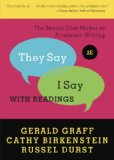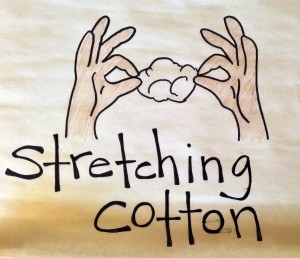 In the last post, I shared the new argumentative focus I'm experimenting with for the article of the week (AoW) assignment. Rather than choosing just any type of article, I'm looking for articles that argue. [1]
In the last post, I shared the new argumentative focus I'm experimenting with for the article of the week (AoW) assignment. Rather than choosing just any type of article, I'm looking for articles that argue. [1]
It's not exactly the discovery of the polio vaccine, but still, it's pretty cool.
I like this new focus because one of my key hopes for AoW is that my kids won't merely become aware of something that's happening in the world — like, in last week's article, the growing popularity of largely unregulated e-cigarettes — but that they'll also see current issues as argumentative conversations, held at water coolers and bus stops and in editorial pages and the blogosphere.
But I want more than that — I also want each article to allow my students to join in on the conversation.
Jacket on, jacket off
The problem with joining in on the conversation is that, although my teenage students (like yours) are passionate arguers in whatever topics they like to nerd out about outside of school — sports, fashion, video games, anime, or whatever — they often lack the tools for entering into argumentative conversations in academic, professional, or civic realms.
Basically, they are Luke Skywalker prior to his time with Yoda, or Anakin prior to his time with Obi Wan, or the karate kid prior to his time with Mr. Han.
And in case a horrible tragedy has befallen your life and you're someone that has not seen the Star Wars series or Karate Kid — and seriously, you should fix this — here's what I'm saying: my teenage students have got lots of spirit and energy, but they lack training and focus.
So it makes sense — beautiful sense — to offer them some scaffolding with which to support their thinking.
But what scaffolding, you may ask? Well, if I were teaching them karate, I might have them do something like this (click here if you can't see the embedded video below):
 But since we're trying to teach them to enter into the argumentative conversation that includes our AoW, we need something like the simple, beautiful sentence templates created by power couple Gerald Graff and Cathy Birkenstein in They Say / I Say.
But since we're trying to teach them to enter into the argumentative conversation that includes our AoW, we need something like the simple, beautiful sentence templates created by power couple Gerald Graff and Cathy Birkenstein in They Say / I Say.
But for AoW, I use a Graff/Birkenstein resource that's even more explicitly scaffolded than the sentence templates: a two-paragraph They Say / I Say argumentative writing template (see below) that I first found in Graff's Clueless in Academe. If you haven't bought their books, let me recommend that you rapidly do so; and if you're not feeling the price tags, write a simple, effective resource request email to your principal and make your school buy them!
Here's the two-paragraph template:
The general argument made by author X in her/his work, _______________, is that _______________. More specifically, X argues that _______________. She/he writes, “ _______________.” In this passage, X is suggesting that _______________. In conclusion, X’s belief is that _______________.
In my view, X is wrong/right, because _______________. More specifically, I believe that _______________. For example, ___________. Although X might object that __________, I maintain that _______________. Therefore, I conclude that _______________.
An editable, downloadable version of Graff and Birkenstein's They Say, I Say template

Get this template in the form of a Google Doc.
Get this: I'm requiring that every student use this template until I see they've fully internalized the moves it contains.
But Dave, the children! And their uniqueness! You are grinding down their souls with the mortar and pestle of conformity, you fascist madman!
Tranquilo — take some deep breaths. Here's why I'm requiring the two-paragraph template:
 Like I said in the last post, my kids are struggling to even figure out what an author is arguing. They get sidetracked into random-land. When they debate, I see the same thing happening. This template, in its first sentence, allows me to see if they've got the general argument pinned. It also helps them internalize that the general argument is what an effective arguer focuses on — not debatable side points.
Like I said in the last post, my kids are struggling to even figure out what an author is arguing. They get sidetracked into random-land. When they debate, I see the same thing happening. This template, in its first sentence, allows me to see if they've got the general argument pinned. It also helps them internalize that the general argument is what an effective arguer focuses on — not debatable side points.- True argument involves building off the ideas of others; it's not simply spouting off your opinion and, if you're really snazzy, giving a cursory mention of what someone else said. My kids/contemporary Americans struggle with this, and so I love that the entire first paragraph of the template is all about, as my friend E-Cash-Money says, “pulling apart the cotton” of someone else's argument and really examining it.
- When making their claims, my students often fail to ensure their claim is clearly understood. The template has students state a claim, then state it more specifically, then give an example to illustrate it, and then deal with how a naysayer may respond to it. Boom. Awesome.
- Effective arguers naturally predict what a naysayer might say. Ironically, some are concerned that the Common Core's emphasis on argument is going to create a more fragmented society, but I would argue that nothing is better than argument at helping people to see any given issue from a myriad of sides. I'm not aiming for pithiness when I say that real argument drives people together; I see it in my classroom every year.
And so, yes, maybe I am crushing the butterflies that are my students' precious souls by requiring them to use the two-paragraph They Say / I Say template for every AoW from now until it's no longer needed.
But I don't think so. I think I'm helping them to put the jacket on and take the jacket off, like Jaden Smith in the Karate Kid mentioned above. And just like Jaden eventually saw that the jacket thing was slowly, imperceptibly training his mind and body to do some wicked kung fu, so, too, will this two-paragraph template help my students internalize the basic moves of argumentation.
“Daniel-San, this not tournament! This for real!”
 Now, one reason my students are willing to do this kind of work is because they've tasted and seen that argument is good, through some simple, time-efficient, in-class debates. So far this year, we've held 7 whole-class arguments, on topics ranging from “Is America the best nation in the world?” to “Were the Mongols awesome or not, from a world history perspective?” These argumentative events help my students experience how the moves in the They Say / I Say two-paragraph template makes for a more cohesive, entertaining, rigorous debate experience, and that whets their appetite for doing the hard work in writing arguments.
Now, one reason my students are willing to do this kind of work is because they've tasted and seen that argument is good, through some simple, time-efficient, in-class debates. So far this year, we've held 7 whole-class arguments, on topics ranging from “Is America the best nation in the world?” to “Were the Mongols awesome or not, from a world history perspective?” These argumentative events help my students experience how the moves in the They Say / I Say two-paragraph template makes for a more cohesive, entertaining, rigorous debate experience, and that whets their appetite for doing the hard work in writing arguments.
Basically, to keep the Karate Kid metaphor going, these debates are the tournament where my students get to taste the fruits of their They Say / I Say writing labor.
I'd like to go into greater depth about how we use debates with AoW in a future post, but in the meantime, check out this post where I discuss them in some detail.
So that's that. What do you think? How is argumentative writing going in your classroom right now? What are you doing to scaffold it and why?
Have a great week!
Footnote:
- In case you aren't aware of this, Kelly Gallagher is the person from whose work I first learned about AoWs. More on that here.
Kris Stanek says
Great resource! Any way to get this on Pinterest?
davestuartjr says
Kris, that is a great question! I will look into it…
davestuartjr says
I think I’ve got it, Kris — I added a “Pin It” button that seems to work!
Chad Walden says
Dave, do you have a paragraph that successfully models this template for the kids, so they can see how it might look with the blanks filled in?
davestuartjr says
Hi Chad,
I’m working on a post to dominate this question in depth — it’s a great one! — but in the meantime, check out the example below.
https://docs.google.com/document/d/1kLA7LHufLxMDQ1LNcyXr4B3NF69xhefg1dje6wOEQ5I/edit?usp=sharing
Chad Walden says
Beautiful — exactly what I was looking for! Thanks, Dave.
SajaH says
Thanks! this is so helpful. After reading (okay skimmed) George Hillocks’ book Teaching Argument Writing, I used his crime puzzles with a group of learners –mostly to change up the pace. They ate it up, so I’m returning with a writing workshop based on mysteries to help middle schoolers learn to set up arguments with evidence. The high school group will receive some of the same, but I like the idea of using the AoW to show them the well crafted (and not so well crafted) arguments that surround us. Your model will help us stay on track.
Dulcy Wells says
Dave, I am such a fan! 🙂
I am so very excited to try the 2 paragraph template with the AOW!
I appreciate what you do for the benefit of all of our students. Thanks
davestuartjr says
Dulcy, thank you for the shout out! Let me know how it goes! 🙂
Vicki says
Dave, I’m really intrigued by the template for argument writing, but I teach fifth grade, and the template seems to be at a much higher level. Any suggestions? Has anyone used this in the lower grades?
davestuartjr says
Hi Vicki,
Sadly, I don’t know of any work in leveling the templates down to 5th grade. However, I do hear murmurings that a They Say / I Say for high school could be in the works, and it’s possible that that could be more scalable down to a 5th grade level.
jarhartz says
Love this, especially the Jacket on Jacket off thing. In we need to practice in these ways before we can compete in many sports. The fact that you are teaching argument like a sport is commendable. We need to see more in this light. Thanks for the sentence frames. Even though I teach 5th graders I can see using this to help them in their debate skills.
jarhartz says
I read Vicky’s comment after I commented, so here’s how I might try for my 5th graders:
The argument made by author X in the article, _______________, is that _______________. To prove/support his/her view X argues is that_______________. She/he writes, “ _______________.”
In my view, X is wrong/right, because _______________. More specifically, I believe that _______________. For example, ___________. Another reason I believe this to be true is ______________ Although X might object with my point of view, I maintain that _______________ because _______________.
This uses language they are familiar with while taking it up a notch with words like “maintain”. I also think you can up this framework as they become more familiar with it.
davestuartjr says
This is so cool — thank you!
Mary Lou says
This confirms what I just started doing with article of the week in AP Lang. I just started having them argue whether they agree or disagree with the article of the week’s argument. Love this format!
Cynthia says
Hi Dave,
Would you be willing to model a lesson for doing this template or do you know of a video lesson that might show how to model it for students. I’m seriously considering doing this because I’m having to really scaffold the AOW’s quite a bit. Would love to see a model lesson if one is out there. Cynthia in TX
davestuartjr says
Cynthia, I’m going to add this to the list of posts to write this fall. I’ll work on a video for this one as well!
Karyn Gloden says
Purchased the Graff /Berkenstein book based on your recommendation–thanks! Definitely worth it.
dgtwrereeprklr@gmail.com says
Is there any way to get the answer key to this google doc
murraymargaret says
Thanks for these tips and will use snippets of your ideas into my lesson plans…article of the week